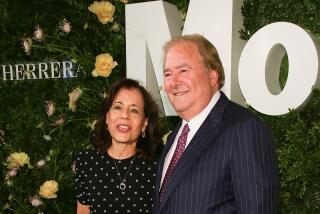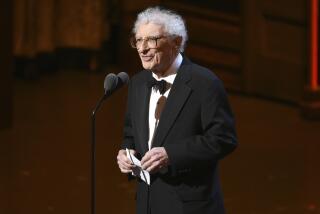POP MUSIC REVIEW : For Young Harry Connick, Old Times Are Good Times
- Share via
COSTA MESA — Remember how some purists back in the ‘60s used to get allexercised wondering whether a white man could sing the blues?
Harry Connick Jr.’s rise poses a parallel question: Can a young man sing the olds?
At 22, the singer-pianist has found a mass audience while moving along the most unlikely path to pop stardom: In a rock ‘n’ roll age, Connick is staking his claim as a singer of Swing Era standards.
Fueled by the success of his album of songs from the film “When Harry Met Sally,” Connick and his 15-man big band played to a sold-out house Saturday night at the Orange County Performing Arts Center. The audience of 3,000 included a substantial number of Baby Boomers who probably were raised on Presley and the Beatles rather than the songs of Gershwin, Ellington, Porter, and Rodgers and Hart, which have formed the core of Connick’s vocal repertoire.
In one sense, Connick didn’t supply an overwhelmingly affirmative answer to the question of whether a singer who came to majority during Ronald Reagan’s second term can do full justice to songs dating back to Reagan’s Gipper days. Connick’s singing was serviceable and never callow, but it was far from commanding. His tone was nasal, his texture flat. When it comes to singing old standards, Tony Bennett, at 63, and Frank Sinatra, at 74, are better bets today than Connick is ever likely to be.
But overall, Connick showed that he may be just the man to help the Boomers appropriate an older tradition for themselves. He performed with a showman’s flair and an enthusiasm for his music that could inject it with currency for an audience that otherwise might regard it as nothing more than the soundtrack for an earlier generation’s nostalgia. With his slender, movie-star looks, his retro-elegant fashion style and his hip-shaking, arm-waving stage presence, Connick could be the Broadway tradition’s great re-popularizer (Linda Ronstadt’s Nelson Riddle-aided albums of standards were hugely successful, but only a temporary dalliance).
In fact, a generational and stylistic bridge of sorts went up when Connick, after a thunderous four-minute call for one last encore, finished his show with a fast and flashy barrelhouse piano boogie that would have done Jerry Lee Lewis proud.
Connick opened with pop standards--Cole Porter’s breezy “It’s Alright With Me,” followed by a run of nuggets from the “When Harry Met Sally” album. But, as he would throughout the show, he cut back in a new stylistic direction, leading his band through a long, undulating, punchy instrumental piece that he kicked off with a gospel-tinged piano intro. A hard-swinging trumpet solo by Leroy Jones sparked the number, prompting a fiery piano surge from Connick. A many-dimensioned player, Connick moved freely between swing sources and the distinctive, choppy-but-rolling stride piano style of his hometown, New Orleans.
For the most part, though, he was inclined to keep himself reined in, with playing that was assured, tasteful and orderly, but rarely gripping or surprising.
Connick kept the music bright and feisty through most of his two-hour set, but that became wearing after a while in a concert that could have used a few more reflective moments. One welcome change of pace was “Forever, for Now” from Connick’s new album, “We Are in Love,” which features sharp Connick originals inspired by the standards of the ‘30s and ‘40s. “Forever, for Now” was furtive, taut and fast-moving in a way well suited to the song’s depiction of a short-lived but ardor-filled fling.
A pretty, humid solo set-piece by tenor saxophonist Ned Gould provided the show’s one quiet interlude. Less effective was Connick’s attempt at the New Orleans funeral march “Just a Closer Walk With Thee.” His voice lacks the body and the soul for gospel singing, and it was hard to believe that this brash, self-confident bandleader had suddenly turned into a grieving petitioner for salvation. Even with a banjo thrown into the arrangement, and the traditional musical upsurge and jubilant dancing around that marks the end of a New Orleans jazz funeral, Connick and his cohorts weren’t a match for the authentic paraders of the Preservation Hall Jazz Band.
Connick made his personality almost as much a factor in the show as his musicianship. He was alternately humorously chatty and Southern-boy sincere. And he wasn’t averse to pointing out his unusual standing in the music world: “I’m a young man who has had a chance to travel around the world with a big band. That hasn’t been done in a long time. Some said it couldn’t be done.” Connick also wasn’t bashful about proclaiming the quaility of his band--to the point where the hyperbolic praise became annoying hucksterism. It’s a fine thing to see a bandleader show affection and admiration for his musicians, and Connick’s ensemble was first-rate. But he overdid the hosannas, repeatedly anointing this or that player as the world’s best on his instrument.
Connick also was a little too sure of his opinions. It was one thing to joke sardonically about tossing in a song by Aerosmith or Guns N’ Roses. But Connick revealed himself a snob when he started going on about “the ‘40s . . . when the music was on an infinitely higher level” than today’s pop, 99% of which he labeled “blatant and classless.” If Connick’s role is to bring the Swing Era’s style and grace to new, rock-tuned ears, boxing those ears with dismissive, unfounded generalizations isn’t going to help his cause.
More to Read
The biggest entertainment stories
Get our big stories about Hollywood, film, television, music, arts, culture and more right in your inbox as soon as they publish.
You may occasionally receive promotional content from the Los Angeles Times.










